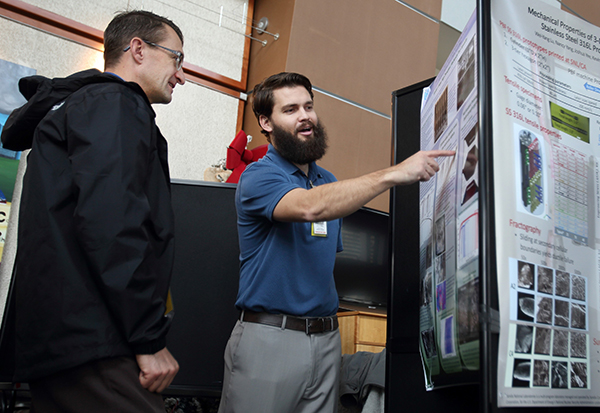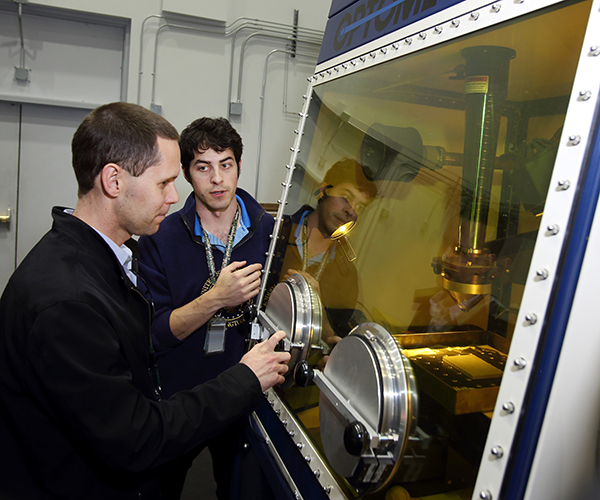Symposium focuses on additive manufacturing’s future

With some $20 million invested into more than 80 additive manufacturing (AM)-related research projects, Sandia’s commitment to additive manufacturing is clear. The challenge going forward is to synthesize the lessons from these disparate projects to realize the potential of this technology.
“We have to work across programs, across disciplines, across sites, and line organizations,” says Christian Mailhiot (8300), senior manager for chemistry, combustion, and materials. To this end, Sandia hosted its second annual additive manufacturing symposium at Sandia/California on Jan. 11. Around 100 people attended either in person or via teleconference to share progress toward integrating AM into Sandia’s national security mission.
AM, commonly known as 3-D printing, is a promising alternative to standard manufacturing for two big reasons: time and money. The raw materials for an object are made while the object itself is being created. This dramatically shortens the design and manufacturing process, potentially resulting in huge cost savings. It also enables the design of objects that simply weren’t possible through traditional manufacturing.
Because AM is still relatively new, the “process- properties-performance” relationship has not yet been established. That is, the relationship between how AM objects are made, the physical properties of the objects, and ultimately how they perform in various environments need to be better understood. The unknowns in this relationship are largely what has kept NNSA from accepting AM parts into the nuclear weapons stockpile.

Glimpses into current projects
The first half of the symposium — organized by managers Jonathan Zimmerman (8367) and Deidre Hirschfeld (1832) — featured a series of talks on aspects of integrating AM into the NW mission. In his introductory remarks, Mark Smith (1801), deputy director of additive manufacturing, shared the progress made at the Laboratories with this relatively new technology. Mark emphasized recent advances in materials assurance, design, and analysis, and multi-material AM, the core themes around which most of the current research and design work is done.
Tom Reynolds (8248) discussed prototype AM parts being designed and built for potential use in the W80-4 Life Extension Program (LEP), which is refurbishing the W80 warhead with replacement components for aging technology. Philip New (425) spoke about the difficulty in qualifying AM parts and the need to certify the design of those parts. Other qualifying considerations include calibration data and firmware of AM machines, and qualifying the people operating the machines as well as the powders used in the process.
In another presentation, Rick Kellogg (2616) made the case for the Smart Multi-Material AM project (Smart-MAM), an advanced multi-material manufacturing capability. It could be used to build electromechanical and sensing capabilities into the same device right alongside with the device’s structural materials.
This could eventually enable the production of entire components in as little as one day with no hands-on assembly.
“This could eventually enable the production of entire components in as little as one day with no hands-on assembly,” he explained. “Developing this type of AM would provide an unprecedented foundry-like capability to additively manufacture components and packaging for weapons and other systems.”
The latter half of the symposium featured a poster session on AM projects currently under way. One of several posters presented by Nick Leathe (2616) focused on the development of shock-absorbing structures. Materials can behave elastically like a rubber band or spring, where the material eventually returns to its original state. This team is trying to make metal behave elastically to increase the amount of shock it can absorb. The project, in partnership with University of Texas, Austin, is in its third year. In 2017, the team will build and test the models they’ve developed.
Weapons parts are by no means the only application for AM parts. Maher Salloum (8959) and David Robinson (8341) presented a poster on a project to model the flow of fluid undergoing a chemical reaction while moving through a solid object, like the function of a catalytic converter in a car. Special surfaces inside a catalytic converter transform a car’s exhaust into more benign components, resulting in less offensive exhaust.
Maher and David’s team is modeling fluids zigzagging through structures in three dimensions. If all parts of the flow structure are evenly utilized, the structure can be smaller. In the case of an engine, this translates into higher efficiency. This year, the team will be conducting flow tests on the objects they’ve designed.
Looking toward the future
Additive manufacturing is not new to Sandia. In fact, Sandia helped develop two additive manufacturing techniques in the 1990s. One of these 3-D processes is robocasting, which forces a ceramic slurry through a pressurized needle to create a part that is then hardened in a furnace. The other process is known as Laser Engineered Net Shaping (LENS), in which complex metal parts are printed from powders.
Last year, a new LENS machine was installed in the Combustion Research Facility at Sandia/California. Its location within the Livermore Valley Open Campus facilitates increased external collaboration with industry and research universities including UC Davis, Berkeley, and Irvine. Symposium attendees viewed the machine during a tour of AM facilities at Sandia/California, which included capabilities for 3-D printing of plastic parts.
“We wanted the symposium to be a networking and collaboration opportunity,” says Jonathan. “It was successful in that respect, so expect another one next year.”
Given Sandia’s leadership around multi-materials as well as partnerships with numerous universities, the Kansas City National Security Campus, Los Alamos, Lawrence Livermore, and Oak Ridge national labs, a new day is indeed dawning for AM research at Sandia.